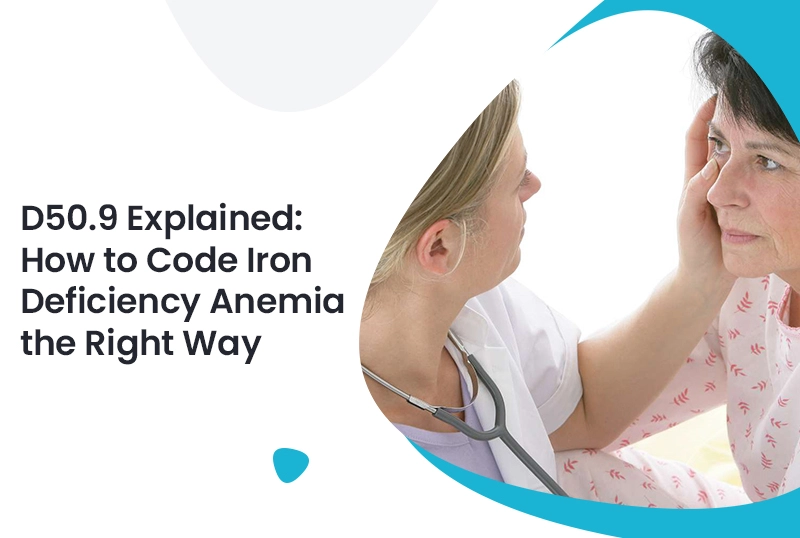Iron deficiency anemia might be common, but coding it incorrectly? That’s a costly mistake. Enter D50.9, the CAD ICD 10 code for iron deficiency anemia, unspecified.
Whether you’re a solo provider or a multi-specialty clinic, getting this code right is crucial for timely reimbursement and accurate medical records. And here’s the kicker: even though it’s labeled “unspecified,” you still need precise documentation.
Partnering with a medical billing service helps ensure codes like D50.9 are correctly used, modifiers are applied when necessary, and payer rules are followed. It’s about protecting your revenue and your reputation.
So, let’s walk through what D50.9 means, when to use it, and how to avoid the common mistakes that lead to claim denials.
What Is D50.9 and When Should You Use It?
The code D50.9 is the CAD ICD 10 designation for iron deficiency anemia, unspecified. It’s used when lab tests confirm anemia related to low iron levels, but the exact underlying cause isn’t identified or documented.
When is D50.9 appropriate?
- Patient presents with fatigue, pallor, or dizziness
- Lab work shows low hemoglobin and low ferritin
- No other known type of anemia or iron loss is identified
However, use this code only when a more specific diagnosis isn’t available. If anemia is due to chronic blood loss or a malabsorption condition, use a more detailed ICD-10 code from the D50–D53 range.
What makes D50.9 tricky?
- It’s often overused when providers don’t dig into the root cause
- It lacks specificity, so payers may flag it for documentation review
- It can’t justify certain treatments (like IV iron infusions) without supporting detail
That’s why accurate, detailed charting is your best defense and your best offense.
Best Practices for Documenting Iron Deficiency Anemia
To support the use of D50.9, your documentation should clearly describe:
- Patient symptoms (e.g., fatigue, weakness)
- Lab results showing low hemoglobin, hematocrit, or iron levels
- Absence of a clear etiology if you’re using the unspecified code
- Treatment plan (oral iron, dietary advice, IV iron if medically justified)
Providers often struggle to balance speed with thoroughness in documentation. That’s where technology and systems come into play. For example, pre-filled templates can help, but only when customized to reflect patient-specific findings.
In larger practices, coordination between billing, providers, and admin staff is key. And if your practice handles the onboarding of new physicians or NPs, credentialing services ensure those providers can bill without costly delays.
CPT Codes That Pair with D50.9
Diagnosis is one side of the coin, procedures are the other. Here are some CPT codes commonly paired with D50.9:
- 36415: Venipuncture for lab testing
- 85610: Prothrombin time (often checked in anemia workups)
- 96365: IV infusion, initial (if iron infusions are administered)
- J1756: Iron dextran injection
- J2916: Sodium ferric gluconate complex (iron treatment)
Billing these CPTs with D50.9 requires supporting documentation. Don’t assume “the coder will figure it out.” Clear notes = fewer delays.
Also, if a payer requires prior authorization for iron treatments, missing or vague documentation can hold up care and payment.
Common Coding Pitfalls and How to Avoid Them
Let’s look at a few common missteps:
Using D50.9 as a catch-all
It may seem easy, but using D50.9 for every anemia diagnosis puts you at risk for denials. Always document thoroughly and choose a more specific code when available.
Missing documentation
If your notes lack lab values or don’t explain why you’re using an unspecified code, the payer may ask for additional records or flat out reject the claim.
Incorrect sequencing
D50.9 might not be the primary diagnosis if the anemia is secondary to another condition (like chronic kidney disease). Always code the underlying cause first if known.
Following a standardized process for charting, coding, and submitting claims is critical, and that’s where revenue cycle management services can help streamline your workflow and keep denials to a minimum.
Conclusion
D50.9 might seem simple, but there’s more to it than meets the eye. Proper documentation, thoughtful coding, and alignment between your clinical and billing teams make all the difference.
With the right strategy, you won’t just get paid, you’ll get paid faster and more consistently.
Let Precision Hub support your team with everything from claims management to revenue cycle management services designed to boost efficiency and ensure compliance, so you can focus on delivering quality care while we handle the backend.
FAQs
1. What does D50.9 mean?
D50.9 is the ICD-10 code for iron deficiency anemia, unspecified. It’s used when anemia is confirmed but the cause is not identified.
2. Is D50.9 a billable code?
Yes, D50.9 is a billable diagnosis code, but it must be supported by detailed documentation and appropriate CPT codes.
3. Can I use D50.9 if I know the cause of anemia?
No. If the cause is known (e.g., blood loss, chronic illness), a more specific ICD-10 code should be used instead.
4. What kind of treatments require D50.9 for reimbursement?
Treatments like oral or IV iron may be billed with D50.9, provided medical necessity is documented clearly.
5. Why do claims with D50.9 get denied?
Common reasons include lack of specificity, missing lab data, or incorrect pairing with procedure codes.







